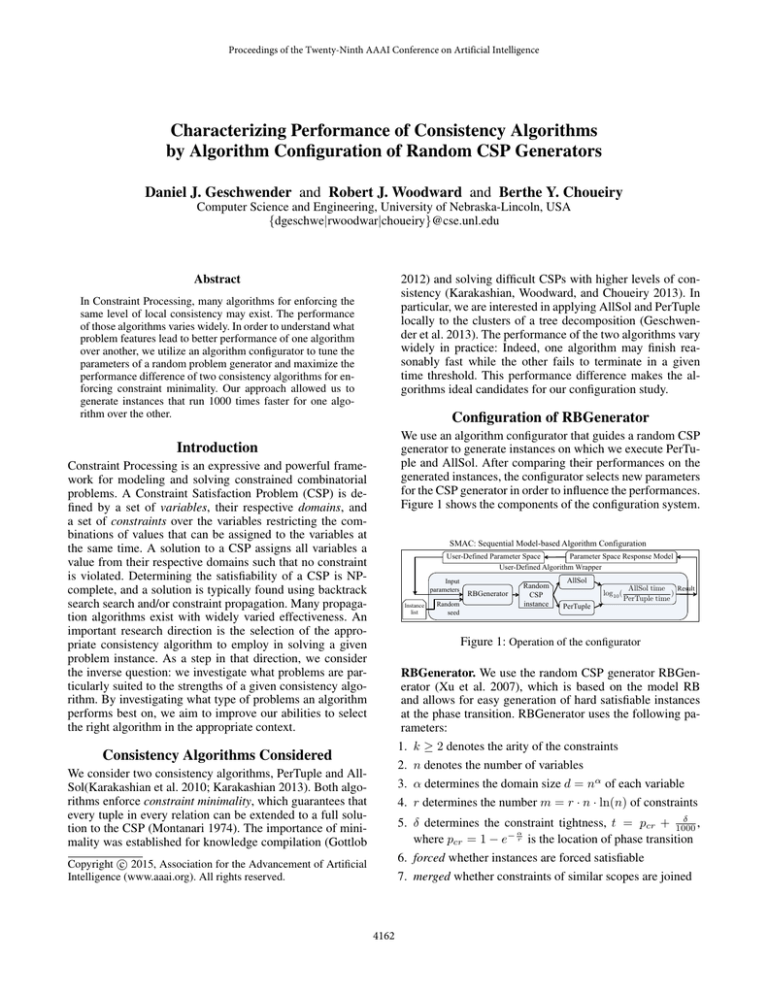
Proceedings of the Twenty-Ninth AAAI Conference on Artificial Intelligence
Characterizing Performance of Consistency Algorithms
by Algorithm Configuration of Random CSP Generators
Daniel J. Geschwender and Robert J. Woodward and Berthe Y. Choueiry
Computer Science and Engineering, University of Nebraska-Lincoln, USA
{dgeschwe|rwoodwar|choueiry}@cse.unl.edu
Abstract
2012) and solving difficult CSPs with higher levels of consistency (Karakashian, Woodward, and Choueiry 2013). In
particular, we are interested in applying AllSol and PerTuple
locally to the clusters of a tree decomposition (Geschwender et al. 2013). The performance of the two algorithms vary
widely in practice: Indeed, one algorithm may finish reasonably fast while the other fails to terminate in a given
time threshold. This performance difference makes the algorithms ideal candidates for our configuration study.
In Constraint Processing, many algorithms for enforcing the
same level of local consistency may exist. The performance
of those algorithms varies widely. In order to understand what
problem features lead to better performance of one algorithm
over another, we utilize an algorithm configurator to tune the
parameters of a random problem generator and maximize the
performance difference of two consistency algorithms for enforcing constraint minimality. Our approach allowed us to
generate instances that run 1000 times faster for one algorithm over the other.
Configuration of RBGenerator
We use an algorithm configurator that guides a random CSP
generator to generate instances on which we execute PerTuple and AllSol. After comparing their performances on the
generated instances, the configurator selects new parameters
for the CSP generator in order to influence the performances.
Figure 1 shows the components of the configuration system.
Introduction
Constraint Processing is an expressive and powerful framework for modeling and solving constrained combinatorial
problems. A Constraint Satisfaction Problem (CSP) is defined by a set of variables, their respective domains, and
a set of constraints over the variables restricting the combinations of values that can be assigned to the variables at
the same time. A solution to a CSP assigns all variables a
value from their respective domains such that no constraint
is violated. Determining the satisfiability of a CSP is NPcomplete, and a solution is typically found using backtrack
search search and/or constraint propagation. Many propagation algorithms exist with widely varied effectiveness. An
important research direction is the selection of the appropriate consistency algorithm to employ in solving a given
problem instance. As a step in that direction, we consider
the inverse question: we investigate what problems are particularly suited to the strengths of a given consistency algorithm. By investigating what type of problems an algorithm
performs best on, we aim to improve our abilities to select
the right algorithm in the appropriate context.
SMAC: Sequential Model-based Algorithm Configuration
Parameter Space Response Model
User-Defined Parameter Space
User-Defined Algorithm Wrapper
Input
parameters
Instance
list
Random
seed
RBGenerator
Random
CSP
instance
AllSol
log10 (
PerTuple
AllSol time
Result
)
PerTuple time
Figure 1: Operation of the configurator
RBGenerator. We use the random CSP generator RBGenerator (Xu et al. 2007), which is based on the model RB
and allows for easy generation of hard satisfiable instances
at the phase transition. RBGenerator uses the following parameters:
1. k ≥ 2 denotes the arity of the constraints
2. n denotes the number of variables
3. α determines the domain size d = nα of each variable
4. r determines the number m = r · n · ln(n) of constraints
Consistency Algorithms Considered
We consider two consistency algorithms, PerTuple and AllSol(Karakashian et al. 2010; Karakashian 2013). Both algorithms enforce constraint minimality, which guarantees that
every tuple in every relation can be extended to a full solution to the CSP (Montanari 1974). The importance of minimality was established for knowledge compilation (Gottlob
δ
5. δ determines the constraint tightness, t = pcr + 1000
,
α
−r
where pcr = 1 − e
is the location of phase transition
6. forced whether instances are forced satisfiable
7. merged whether constraints of similar scopes are joined
c 2015, Association for the Advancement of Artificial
Copyright Intelligence (www.aaai.org). All rights reserved.
4162
Sequential Model-based Algorithm Configuration. To
tune RBGenerator’s parameters, we use of the algorithm
configurator “Sequential Model-based Algorithm Configuration” (SMAC) (Hutter, Hoos, and Leyton-Brown 2011).
We give SMAC a list of the input parameters with ranges
and default values. We provide a list of 30 instances (in this
case, random seeds for the RBGenerator). Finally, we give
SMAC a custom algorithm wrapper that runs RBGenerator,
PerTuple, and AllSol. SMAC takes an initial default configuration, performs an algorithm execution, and determines
its performance based on the wrapper output. It iterates the
process, selecting new configurations (based on a continually improving regression model) and evaluating them.
Algorithm Wrapper. The algorithm wrapper encapsulates
several programs to be run together. Initially, RBGenerator
runs with the parameters provided by SMAC, and generates
a CSP instance on which our two consistency algorithms
PerTuple and AllSol are then executed. The execution times
of PerTuple and AllSol are recorded, and are compared by
taking the base-10 logarithm of their ratio. Taking the logarithm ensures that equal weights are given to fractional values when the results are averaged in SMAC’s model.
10000
Configuration of Instances Favoring PerTuple
Configuration Seed
1
2
3
4
5
6
7
8
9
10
PerTuple Speedup
1000
100
10
1
0
50000
100000
150000
200000
Configuration Time (seconds)
250000
Figure 2: Improvement of the adjustable-PerTuple configuration.
Conclusions & Future Work
We successfully used configuration on a random CSP generator to create problem instances favoring PerTuple over
AllSol and vice versa. The ratio of the execution time difference was in excess of 100. Additionally we have shown
that highly constrained problems favor AllSol and underconstrained problems favor PerTuple. We intend to use this
information in building an algorithm portfolio. In the future,
we will apply our approach to other algorithms, both for enforcing the same and different levels of consistency. Further,
we will use other generators with more configuration parameters in order to capture deeper behaviors of the algorithms.
Experimental Results
Acknowledgments: Supported by NSF Grant No. RI-111795.
Geschwender was also supported by NSF GRF Grant No. 1041000
and a Barry M. Goldwater Scholarship, and Woodward by NSF
GRF Grant No. 1041000 and a Chateaubriand Fellowship. Experiments conducted at UNL’s Holland Computing Center.
In our experiments, we evaluate how well SMAC is able
to generate instances that favor a given algorithm. To this
end, we test two cases: those where SMAC is allowed to
adjust all parameters (denoted adjustable size), and those
where SMAC has a restricted set of parameters (denoted
fixed size). For the restricted set of parameters, we fix n
to 16 and α to 1 (i.e., 16 variables each with a domain
size of 16). Thus, we only allow SMAC to control the constraints and not the size of the CSP. For each the fixed and
adjustable cases, we generate instances favoring PerTuple
and instances favoring AllSol (for a total of four tests). Each
test is performed with ten different configuration runs, each
with a different SMAC configuration seed. Each configuration ran for four days on a single core of an Intel Xeon E52670 2.60GHz processors and given 3 GB memory.
In all four test cases, the configurator finds parameter
settings that cause one algorithm to significantly outperform the other. The average speedup across all 10 seeds for
each test is as follows: adjustable-AllSol: 108, adjustablePerTuple: 981, fixed-AllSol: 98, and fixed-PerTuple: 306.
Figure 2 shows the progressive improvement of the
adjustable-PerTuple configuration over time. The x-axis
shows the amount of time configuration has run, while the
y-axis shows ratio of execution times. The ten lines are the
ten different configuration runs, each with a unique seed.
Our approach allowed us to identify the r and δ parameters as important for the configuration. We found that low
values of r and δ (fewer, looser constraints) favor PerTuple,
and high values of r and δ (more, tighter constraints) favor
AllSol. To apply this to real-world problems, a measure such
as constrainedness (Gent et al. 1996) may be used. For additional detail on our experiment and results, see our technical
report (Geschwender, Woodward, and Choueiry 2014).
References
Gent, I. P.; MacIntyre, E.; Prosser, P.; and Walsh, T. 1996. The
Constrainedness of Search. In Proc. of AAAI 1996, 246–252.
Geschwender, D.; Karakashian, S.; Woodward, R.; Choueiry, B. Y.;
and Scott, S. D. 2013. Selecting the Appropriate Consistency Algorithm for CSPs Using Machine Learning Classifiers. In Proc. of
AAAI 2013, 1611–1612.
Geschwender, D. J.; Woodward, R. J.; and Choueiry, B. Y. 2014.
Configuring Random CSP Generators to Favor a Particular Consistency Algorithm. Technical Report TR-UNL-CSE-2014-0003,
University of Nebraska-Lincoln.
Gottlob, G. 2012. On Minimal Constraint Networks. Artificial
Intelligence 191-192:42–60.
Hutter, F.; Hoos, H. H.; and Leyton-Brown, K. 2011. Sequential
Model-based Optimization for General Algorithm Configuration.
In Proc. of LION5 2011, 507–523.
Karakashian, S.; Woodward, R. J.; Reeson, C.; Choueiry, B. Y.; and
Bessiere, C. 2010. A First Practical Algorithm for High Levels of
Relational Consistency. In Proc. of AAAI 2010, 101–107.
Karakashian, S.; Woodward, R. J.; and Choueiry, B. Y. 2013. Improving the Performance of Consistency Algorithms by Localizing
and Bolstering Propagation in a Tree Decomposition. In Proc. of
AAAI 2013, 466–473.
Karakashian, S. 2013. Practical Tractability of CSPs by Higher
Level Consistency and Tree Decomposition. Ph.D. Dissertation,
University of Nebraska-Lincoln.
Montanari, U. 1974. Networks of Constraints: Fundamental Properties and Applications to Picture Processing. Information Sciences
7:95–132.
Xu, K.; Boussemart, F.; Hemery, F.; and Lecoutre, C. 2007. Random Constraint Satisfaction: Easy Generation of Hard (Satisfiable)
Instances. Artificial Intelligence 171(8):514 – 534.
4163






